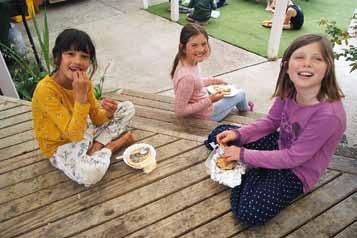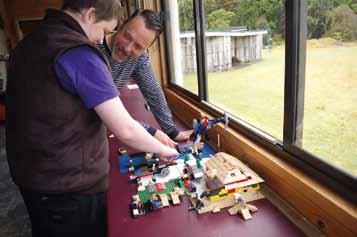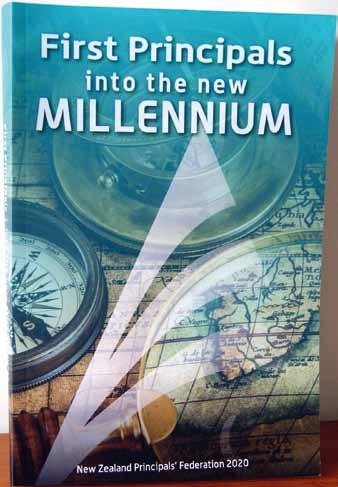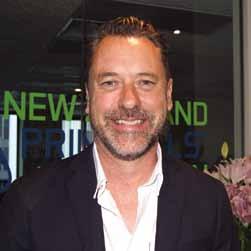
22 minute read
NZPF PreSIDeNT vISITS 3 GreAT bArrIer ISLAND ScHooLS
aotea – Great Barrier islaNd – school liFe W diFFereNce ith a
Liz Hawes
editor
you quIcKLy ruN out of superlatives when describing Aotea Great Barrier Island. It is a place of exquisite beauty to anyone who craves peace and tranquility and yearns to escape the harsh city sounds. Located in the outer Hauraki Gulf, it offers few perceptible intrusions bar the gentle lapping of the sea and the many and varied songs of its profligate bird population.
Threatened species such as the kaka, the banded rail, the brown teal duck and New Zealand dotterel make Aotea their home, alongside the more common oyster catcher, tui, pukeko, kereru, blue penguin, petrel and gannet. It helps that Aotea has few predators and with help from the Department of Conservation (DOC), who control two-thirds of the Island’s bush covered Here's an example from the balcony of our digs! conservation park, predators are kept at low levels. The aspiration is of course to eradicate all pests, and rat-trapping is a big part of that.
Aotea has not escaped kauri die back disease and DOC workers are regenerating the kauri stands. Maintaining and cutting the many walking tracks through the pristine native bush of the conservation park is another key task for DOC.
The splendid rocky outcrops and beaches of Tryphena, Okupu and Whangaparapara on the west coast, contrast with the sweeping golden sandy beaches of Medlands, Kaitoke and Whangapoua in the east. It is not unusual to be entertained by the antics of Orca or Minke whales and dolphins as you sip your coffee in a Tryphena café and if the whales and dolphins aren’t performing, there’s bound to be a few kayaks and fishing boats to catch your attention.
Aotea is largely uninhabited, except for the 800 or so residents who populate the southern end of the island, in the service communities of Tryphena and Claris (which boasts the Island’s main airport) and at the northern end, Port Fitzroy and Okiwi. A few working sheep and beef farms dot the landscape along with the manuka and bush honey producers.
Aotea is accessible by (small) plane, ferry or barge. These are also the means by which food, freight and mail arrives on the island. There are three general stores, but if you are expecting supermarkets, you will be deeply disappointed. Stores are located in Tryphena, Claris and Fitzroy, the main island hubs. You can also find the medical centre, pharmacy, police, fire brigade, and garages at Claris. Cafes and restaurants are not plentiful, but some have wonderful names, such as My Fat Puku, The
Currach (Irish Pub), Swallow (hamburger bar), Stray Possum
President Perry rush takes a look at what’s over the school fence. yes, it really is Tryphena bay
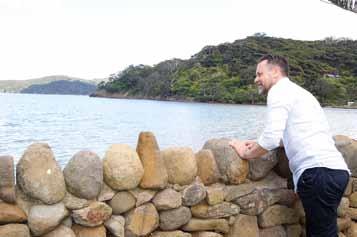
Restaurant & Bar and The Whale Boat (in deference to the colonial whaling industry of the 1800s). If you expect to order excellent local seafood, however, you may be disappointed. Despite the well-stocked local scallop beds, the rock oysters, paua, crayfish, snapper, hapuka, terakihi, kingfish and other local seafood delights are not always available to restaurants and cafes. Rather, these delicacies are more likely to have filled the quotas of Auckland based commercial fisheries, and not be available to Aotea restaurants. If you are a seafood fan, you might need to befriend a local recreational fisherman and invite yourself for dinner.
There are a few things you quickly learn about Barrier life. Petrol is $3.40 a litre, milk is $5 a litre and electricity is not a given. Some families need a wet-back for hot water and coal ranges are still in use in some parts. Once the sun goes down, you are essentially in the dark. There are no road lights to guide you home at night, nor are there any traffic lights or road markings. There is a single sealed road from one end of the island to the
Perry rush entertains the children of mulberry Grove School
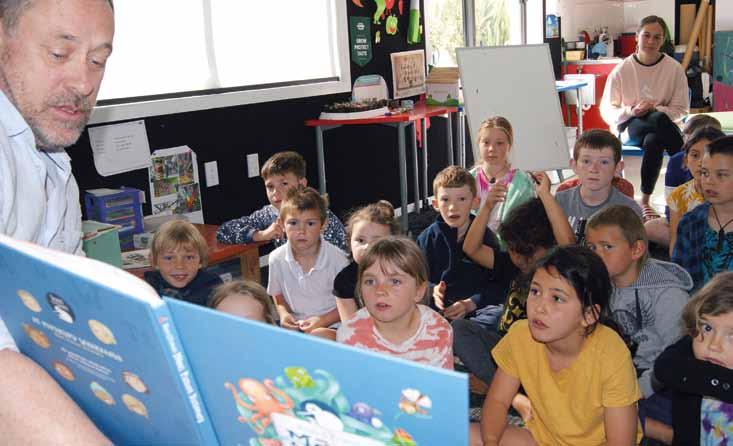
other, but don’t be in a hurry. The road is especially narrow, hilly and very windy.
The lack of ‘light pollution’ means that Aotea qualifies as the world’s only island Dark Sky Sanctuary and attracts astro-tourists from all over the world to participate in star-gazing tours. This means that Aotea is well placed to celebrate Matariki and does so with a month-long festival including astronomy talks and star gazing. This year the festival ended with a chance to see Mars at its brightest and closest since 2003, and what better place to see it with clarity than Aotea?
This is the place where the children of Aotea Great Barrier Island are born, nurtured and grow up. They are closely connected to nature and have a heightened awareness and knowledge of their beautiful environment. They are quite comfortable both in the sea and in the bush. Perry Rush, NZPF president and I visited the three schools on Aotea in October this year. The three schools are quite distinct in their focus with one in the northern Okiwi district, Kaitoke School in Claris and Mulberry Grove in Tryphena. That said, there are also issues they all have in common.
Our visit began with Mulberry Grove School (MGS), Tryphena. Mulberry Grove School (MGS) Principal of MGS, Ally Gibbs, is proud of her 30 students, saying how willing they are to share their fishing and pig hunting stories, how adaptable and resilient they are, and how adept at solving problems. ‘They are free range kids,’ she said delightedly, ‘so they have learned how to look out for each other and be responsible for themselves and the environment.’
‘The school’s curriculum provides the flexibility to focus on the needs and the strengths of the students, using the local environment and community to support classroom programmes,’ says Ally. ‘The students here are also well connected, through the virtual learning network (VLN), to other kids living in isolated places including those in other countries,’ she said. The VLN allows our students to learn foreign languages too and Spanish is a popular choice at MGS. ‘Some students have had three years of Spanish before they start secondary school,’ said Ally.
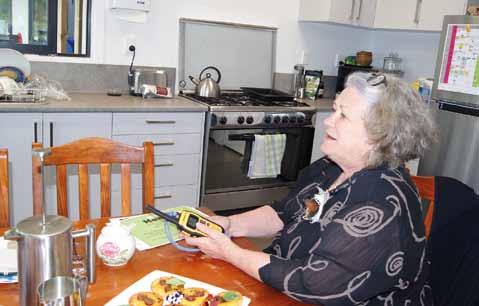
Staying in touch with the community is key to understanding
Ally Gibbs, Principal of mulberry Grove School checks in with the kayakas through her walkie-talkie
the breadth of knowledge out there and Ally is quick to involve those with expertise who are willing to help broaden the curriculum. ‘Take Ian Way,’ says Ally. ‘He is Grandfather to one of our students but is a retired pilot with an interest in model aeroplanes. He is teaching two of our boys, Zac and Cane the theory of flying, aerodynamics and how to read and understand plans and instructions,’ says Ally. The two boys are building model aeroplanes under Ian’s watchful eye and are completely year 7 & 8 kids at mulberry Grove School get ready for a kayak trip to Pa Point engrossed in their learning. Zac already plans to train as a pilot as soon as he is old enough!
Connection to the environment is brought starkly into focus when we talk about the school swimming pool. ‘We have a huge swimming pool,’ says Ally with a grin, ‘See the Bay out there?’ And yes, all the children have swimming lessons in Tryphena Bay which is on the school boundary. ‘We host swimming sports in the summer for all three schools on the Island,’ says Ally, ‘because there’s plenty of room in our pool!’
If we needed any confirmation of the kids love of water sports, come lunch time, we watched the seniors set off with a teacher for an hour’s kayaking round to nearby Pa Bay. ‘They like to jump off the wharf, but today the ferry is in so they can jump in the water from Pa Bay instead,’ said Ally, as she checked in with the teacher via the radio telephone communication system. ‘This is part of our safety procedure,’ she said, ‘Just in case anything goes wrong and we have to get help urgently.’
Another important programme the school offers is Sea Science, supported by the Sea Education Charitable Trust. ‘Our kids learn to sail, kayak and snorkel and we do long jump on the beach,’ she said. They also learn about marine debris and the ‘great Pacific Garbage Patch’ in the Pacific Ocean, made up mostly of plastic.
All three schools on Aotea combined in a beach clean-up in 2017, which became a scientific study to better understand the nature of the rubbish, where the rubbish came from, whether the location of the beach made a difference to the type of rubbish found and how to reduce it.
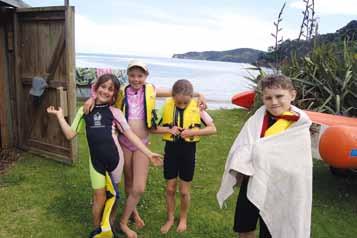
This project was a perfect example of schools collaborating
The vLN corner at mulberry Grove School where the seniors learn Spanish Zac has found his niche making model aeroplanes with the help of former pilot Ian way, from Devon
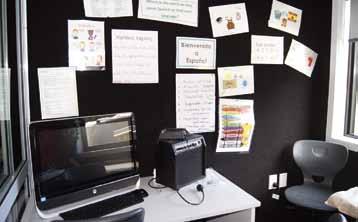
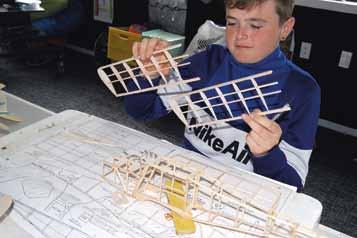
around common goals and objectives. The aim of the study was to enhance their Island environment by systematically analysing the types and effects of rubbish on their beaches. They collected samples, categorised and counted the items of rubbish, recorded and analysed the data and communicated their findings through creative art, sculptures (including sculpting a hammerhead shark), and wall displays, using the marine debris. They wrote poems, songs and a play and made videos of their findings. They then shared their creations with their communities through a hui.
This was followed up with a presentation to a science conference of about one hundred marine scientists and a presentation to over 300 Auckland University students, about how marine debris affects Aotea Great Barrier Island. A community beach clean-up was organised by the children, who invited the community to volunteer and support their efforts and meetings were held with mussel farmers to discuss ways to stop lanyards (rope used for growing mussels) ending up on beaches.
‘This project had everything,’ said Ally. ‘The children used key competencies in working together, they involved all the core subjects of reading, writing and maths and applied science; they collected data and analysed it, categorising and counting all the different types of rubbish; and they summarised their findings by synthesizing all the data and presenting it in pie graphs with a narrative. They then used their public communication skills to present to the different groups, answered their questions and converted their story into Art form. It was a stunningly good project,’ she said.
Building and working on relationships with the community is a critical part of being a principal at MGS. ‘I’m the 30th principal in 50 years,’ she said. ‘It’s important that you are a good fit with the community and it’s not for everybody as the stats show.’
The COVID health crisis was a mixed bag for Ally’s children. ‘Most families have access to the internet so many kids could keep learning from home, but access to devices was an issue with many limited to their parent’s phone,’ she said. ‘The other
COVID related problem was socialisation, especially for only kids,’ she said.
One enduring problem for all Aotea schools is attracting teachers, relievers and teacher aides. ‘It’s difficult, especially with rolls moving up and down,’ said Ally. ‘Teachers are less likely to accept a position with us when they may be out of a job the following year.’
The other common issue is getting access to learning support It takes full attention to write speeches people. ‘We are aware that there is a cost to bringing over RTLB or an RTLit, Educational Psychologists, speech therapists, Oranga Tamariki or mental health service workers to the Island,’ says Ally. ‘At times we have had an inter-agency approach including all the different agencies and the Police too, but then funding was cut. Our learning support services are at best inconsistent,’ she said. This is a constant problem for the school given about one third of the current students would benefit from some learning support assistance. ‘The same applies to PLD,’ she said, ‘and it’s these things that suck the life out of you.’ She did add that being able to access the COVID Urgent Response Fund was hugely helpful and they had been able to relieve some pressure points through that.
Property issues are another common headache for all three schools. Fluctuating rolls place them in the too hard basket.
Whilst in many ways school is an idyllic experience for the children, there are barriers for them too. The biggest is that Aotea kids are zoned for Te Kura, Correspondence School for their Secondary School Education. In other words, there is no secondary school on the Island.
‘Parents all want the best opportunities for their kids throughout their schooling lives. Parents of our kids want their secondary aged kids to have an expanded curriculum and broader socialisation to prepare them for their adult lives,’ said Ally, ‘and that means attending Boarding Schools in Auckland.’
The Ministry of Education does offer a small subsidy to parents of the kids who attend Boarding School but this subsidy is nowhere near enough for many families.
‘In some cases, we lose the whole family, who shift to Auckland once their eldest goes to High School,’ said Ally. ‘In other cases, families struggle on and there are those who just use Te Kura, Correspondence School,’ she said. A hub has been created to support these students, but its no substitute for the real school experience.
Challenges aside, one of the most influential factors in the school’s success is the community spirit. ‘We are so lucky to have such a committed community here,’ she says. ‘just take our school gardens, for example,’ she says, as she leads us outside to inspect the new garden boxes that have just been constructed, ready for the soil to be dug in. ‘All this work has been done by our parents’, she said proudly.
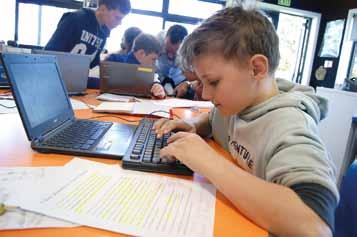
Te Kura o Okiwi
The Fisheries officers come to educate the children at okiwi on the rules of fishing

It’s a slow windy road from Tryphena to Okiwi. We immerse ourselves in the dense fresh bush – much of it regenerating – at the northern end of the island and take in the steep cliffs, deep ravines and spectacular jagged ‘Pinnacles’.
CREATIVE ARTS THERAPY IN SCHOOLS
Following COVID-19 related disruptions to student learning, our experienced therapy team can provide a wellbeing programme tailored to your student's needs.
Group programmes available in schools:
Dance Movement Therapy
Art Therapy
Multi-Modal Creative Arts Therapy
Tailored to children demonstrating:
Mental health issues (including Anxiety & Depression)
Signs of trauma
Lack of ability to focus
Anti-social behaviours
Special needs and/or physical disabilities
Outcomes include:
Improved wellbeing
Increased focus and productivity in the classroom
Enhanced emotional intelligence
Better communication and social skills
Improved coordination and motor function
To find out more, visit: www.dancetherapy.co.nz Email: info@dancetherapy.co.nz, or phone: (09) 636 3029
Kura o Okiwi is the most isolated of the three schools, because of its distance from service centres. Port Fitzroy is the closest and offers a general store and a wharf. Families are scattered. Whilst some children arrive at school by bus, others are bused from the wharf where they have been dropped by boat.
Principal Colin Griffiths is away the day we visit the Okiwi kura but we were well taken care of by Kaimahi Brian Reid. The day began with a mihi whakatau, which is the normal way to welcome visitors at the school. The school population is about 90 per cent
Some children from Kura o okiwi travel to and from school by boat Māori, so English and Te Reo Māori are used interchangeably.
‘We have a big emphasis on taha Māori at our school,’ says Brian, ‘and most of the Kaimahi (teaching staff) are quite fluent in te reo,’ he said.
‘There are families on the Island who want their children to experience a richly Māori education,’ says Brian, ‘so they deliberately choose our school.’
‘We run a tuakana teina system where the older kids look out for and nurture the younger ones,’ he said. ‘In the end this becomes part of our whānau way of being.’
We saw tuakana teina in action when we joined the children who presented prepared statements about who they are, their families, what they and their families like doing and what is special about their families. There was a mix of family types from sole parents to extended whānau families where grandparents had an influential role, particularly in passing on skills and knowledge. We also met descendants of the oldest family on the Island, Richie and Isabella Mabey. The Mabey family has farmed on Great Barrier Island for over a century.
Some children prepared their stories in Te Reo, others in a mix of English and Te Reo, and some in English. If young ones were struggling to read their work, an older student would get up and help them out or hold up pictures for them.
Favourite pastimes were heavily weighted in favour of outdoor activities, and surprisingly not a single child mentioned they played computer games!
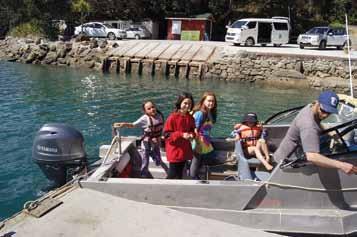
Motorbike riding was a hit amongst a few older boys, but far
The sculpture of the hammerhead shark made from marine debris is displayed at Kura o okiwi Another example of tuakana teina at Kura o okiwi
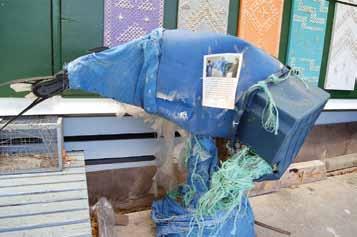
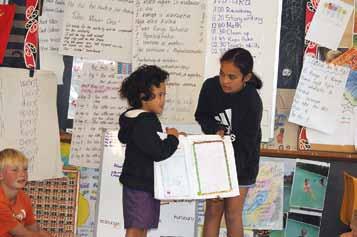
and away the most popular weekend fun was hunting, fishing and diving. This is in part because they said they love eating seafood. Ball games like netball, tennis, soccer, rugby, touch rugby and cricket were also standard fare. Family cats and dogs took the interest of a few and managing litters of new-borns was most exciting.
We learned that several dads work for DOC and in this northern area, rat trapping is a big focus. Others are truck drivers, builders, and tradesmen, mostly in full time work on account of the residential building happening on the Island. Some are propagating native trees to sell, just as children at Te Kura o Okiwi propagate natives to plant. There are creative Mums who like to paint and some are adept at Māori art, others make jewellery.
Indoor favourites included playing chess, drawing, reading, writing, guitar playing and singing. A few like to bake.
Families in this part of the Island are not millionaires so when it comes to school trips, they have to be innovative in their fundraising choices. About twenty years ago, locals decided to gather to watch the Melbourne Cup race on television, and to entertain the young ones, someone suggested snail races. The snail races took on a life of their own and are now the major fundraiser for school trips. The kids are the owners and trainers. They paint their snail shell with a number and people bid on which snail will win. The winner is the first to breach the edge of a defined circle.
‘We now have visiting Russian boaties who regularly come to bet on the snail race and a group of sailors from Tauranga come over every year especially for the event. What is so amusing, is that they are not coming for the Melbourne Cup so much as the snail race!’ said Brian.
The day we visit, two Fisheries Officers Tom and Taylor, are also visiting the school. We sit in on their session with the children. Tom and Taylor are here to educate the children on the rules of fishing, the number of a single species allowed per day and how
big the fish have to be before you can take them home. They also explain the consequences of not following the rules.
They explained their role as being ‘Fish Police’ and began their presentation by asking the children questions. ‘How long does a snapper have to be, to keep it?’ The hands went up quickly, and the question answered correctly. This pattern was repeated for every question.
The children already knew all the rules and were keen to abide by them so that the fishing stocks would be sustained. Indeed, they had questions for the Fishing Police themselves. Like, did they know what commercial fisher-people were doing at night and could they track what they are doing? What was happening about the plastic on the mussel lines which pollutes the sea? These are children for whom the sea is their home and the fish their sustenance.
Kura o Okiwi is a school that actively lives its values of awhinatanga, manaakitanga and whanaungatanga and has very close connections with the two local marae and the local iwi Ngāti Wai. These values and the school’s cultural connections heavily influence the daily curriculum and activities of the school, as do environmental studies. The young people attending this very distinct Kura, will be the bi-cultural kids of the future, capable of walking confidently in two worlds.
Kaitoke School, Claris Kaitoke is the school closest to the airport at Claris. Kaitoke boasts the only natural hot springs on Aotea, a reminder of the Island’s volcanic nature. They are accessible via the Hot Springs track through beautiful native bush or by Whangaparapara Road and a short bush walk.
The children of Kaitoke School welcome President Perry rush to their school

We have no time to indulge in this natural phenomenon unfortunately and motor across the farmlands to Kaitoke school. We meet Leo de Beurs, the principal of nine years, but like Mulberry Grove School, Kaitoke has a history of many previous principals who did not stay long.
‘You have to be a particular person to fit in here,’ says Leo, but we love it.
The students of Kaitoke school essentially come from two main areas. These are Okupu and Whangaparapara. ‘We have a mix of kids here,’ says Leo, ‘with some coming from privileged backgrounds and others living in baches.’
The school is situated on a very generous site and the school, the adjacent playcentre and two schoolhouses are powered by
Worries stick. Let’s help our kids shake them off.
What is Pause Breathe Smile? It’s a mind health programme proudly funded by Southern Cross which equips Kiwi kids with the tools they need to navigate the ups and downs of life and set them up for a healthy future. Research shows Pause Breathe Smile improves focus and attention, helps develop conflict resolution skills, increases self-awareness and reduces stress for teachers. How do I get my school involved? Schools can register their interest by emailing info@pausebreathesmile.nz
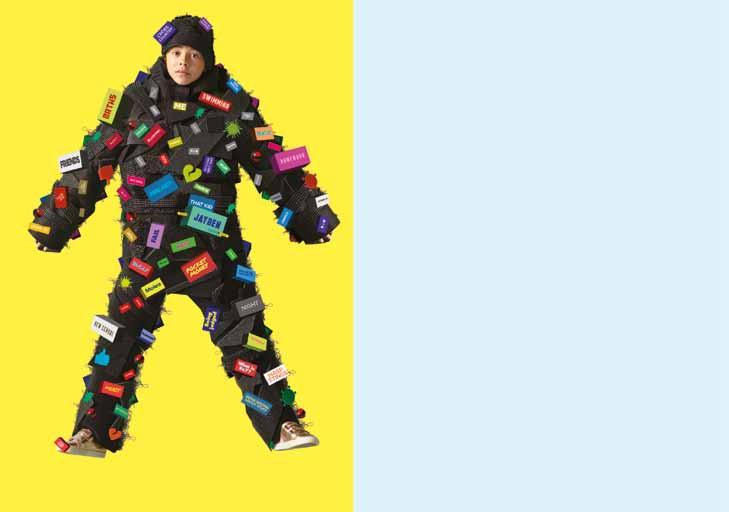
Visit www.pausebreathesmile.nz for information.
Delivered under licence from the
Kaitoke kids enjoy a good joke Principal Leo de beurs, Kaitoke, has a laugh with Perry

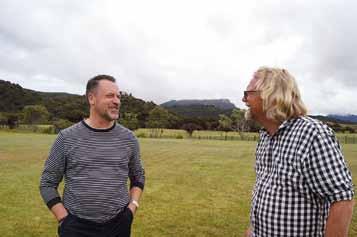
48 solar panels, 24 large storage batteries and 2 large generators. We get to chat to some of the senior students who are looking ‘This is all Ministry of Education land,’ said Leo, ‘It is a huge ahead to secondary school. There’s a fairly even divide between expanse because there was an intention to those who are intending to go to Epsom build an Area School here, but that has not Girls’ Grammar School and those who will eventuated,’ he said. stay on the island and do high school work
Like all the Aotea schools, Kaitoke operates by correspondence, and much does depend a whānau model, where older kids look after on finances, not their individual potential to younger ones. It is an advantage that Leo succeed. thinks the mainland Intermediate schools One school leaver will leave behind his own don’t have. ‘By retaining our year 7 and 8 kids, enduring legacy. Peter will stay on the island they have the opportunity to learn to take for his high school years but has designed responsibility for supporting and organising a race track which he has named ‘Cartoki and caring for the little ones, which of course City.’ It will take up a metre square area of can’t happen if you take them out and put them the playground and the challenge now is all into Intermediate schools,’ he said. translating the plan onto the plot. Junior
The year 7 and 8 kids from across all the children have helped Peter to dig it out ready schools do have their own social club and for the next stage. His teacher aide and he regular meetups. ‘They have movie nights have been working on this project for a long and swimming, snorkeling and jumping off time now and it is exciting that it will soon rocks and have a meal together. They organise Friday pie day is a big job for pie be taking shape. This lasting legacy will also tramps too and have quiz nights, just for monitor Terri include Peter’s name, etched into the concrete, themselves,’ he said. he told us proudly.
Nature is a prominent feature for Kaitoke school, as it is for all Friday at Kaitoke School is pie day. Like so many food items, the schools, but as Leo says, it’s not always positive. ‘At certain the pies are flown into the island in boxes and delivered to the times of the year the pigs circle our rubbish bins, take what they school for heating. It’s a treat the kids all anticipate with relish. want and off they go,’ he says. ‘They also encroach on private We finish our day with Friday assembly and as the children properties when fruit is ripening and help themselves,’ he says. perform their dances and songs, we resolve to return to this little piece of paradise, called Aotea Great Barrier Island.
Pies make these girls smile! Peter, Kaitoke School, shows Perry another model he has made from Lego
